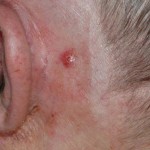( For the texts and pictures books, publications, guidelines for example in awmf.org and contributions of colleagues were consulted.)
 The most common skin cancer is basal cell carcinoma (BCC). BCCs are less aggressive and rarely metastasize. This is a neoplasm derived from cells of basic layer of the epidermis. This is the least dangerous form of skin cancer. Clinically it is usually a nodule pigmented or pink that persists. In some cases it looks like wound that does not heel easily or it is flat, giving the image of a scar. BCC grows slowly and rarely gives metastases. However, we must address it immediately, if diagnosed because delayed removal destroys the tissues deep often reaching up to the bones. An important risk factor for the occurrence of this type of cancer is chronic and prolonged sun exposure. Even basal cell carcinomas occur primarily on UV-damaged skin – although more sporadically strong for their formation – as the chronic UV damage seems to be responsible. Treatment is determined according to the basal cell carcinoma and localization, and is usually surgically.
The most common skin cancer is basal cell carcinoma (BCC). BCCs are less aggressive and rarely metastasize. This is a neoplasm derived from cells of basic layer of the epidermis. This is the least dangerous form of skin cancer. Clinically it is usually a nodule pigmented or pink that persists. In some cases it looks like wound that does not heel easily or it is flat, giving the image of a scar. BCC grows slowly and rarely gives metastases. However, we must address it immediately, if diagnosed because delayed removal destroys the tissues deep often reaching up to the bones. An important risk factor for the occurrence of this type of cancer is chronic and prolonged sun exposure. Even basal cell carcinomas occur primarily on UV-damaged skin – although more sporadically strong for their formation – as the chronic UV damage seems to be responsible. Treatment is determined according to the basal cell carcinoma and localization, and is usually surgically.
The most important factors for developing skin cancer is the type of skin and exposure to sunlight. The best precaution for people at risk is to avoid sun exposure and use of appropriate protective clothing and sunscreen.
In common: Skin cancer treatment
The treatment of small localized basal cell carcinomas can be done with cryotherapy, by spraying with liquid nitrogen. Small lesions may respond to topical treatment with antineoplastic agents such as imiquimod cream (Aldara) or 5 fluorouracil. Most large tumors or cancers that have recurred should always be removed surgically and examined under the microscope. In large tumors occupying a large area there may need skin graft placement in the exclusion of the lesion. Neglected and extensive tumors in elderly patients may require radiotherapy.
Recommendations
Avoid the sun between 11.00 und 15.00 clock.
Apply the sunscreen at least 20 minutes before going into the sun.
Use enough sunscreen to protect the body and face evenly.
Use a product with a high sun protection factor (SPF) in UVA-UVB.
Get used to the sun slowly.
Reapply every one to two hours and immediately after swimming.
Pay particular attention to nose, cheeks, forehead, ears, neck and shoulders, as these areas are particularly exposed to the sun.
Wear a hat to midday, long dress and sunglasses with UVA and UVB protection.
Protect babies to six months entirely by the sun and be very careful with children.
Go at the first sign of sunburn in the shade.
